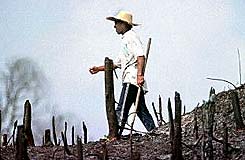| . |  |
. |
|
by Fred Pearce  Hanover - September 29 1999 - Rising levels of greenhouse gases have led to faster tree growth in arid regions. The discovery boosts the case for planting forests in dry areas to combat the effects of global warming.
Hanover - September 29 1999 - Rising levels of greenhouse gases have led to faster tree growth in arid regions. The discovery boosts the case for planting forests in dry areas to combat the effects of global warming.Plants combine water with carbon dioxide to create complex chemicals. Xiahong Feng of Dartmouth College in Hanover, New Hampshire, has shown that the rise in atmospheric CO2 over the past 200 years has made this process more efficient. PHOTO CAPTION: A local farmer in the Brazilian northern state of Roraima walks amidst charred trees 18 March after ongoing fires ravaged through forest and grasslands in this region bordering Venezuela. The drought, caused largely to the meteorological phenomenon 'El Nino,' is blamed by local officials for the fires which have burned a territory as vast as Belgium in the past two months. AFP PHOTO/Jose Paulo LACERDA/AESTADO Feng measured the changing ratio of different isotopes of carbon in the annual growth rings of a range of American trees. Short-term fluctuations reflected seasonal weather patterns, but Feng detected an underlying trend that matched the rise in global CO2 levels (Geochimica et Cosmochimica Acta, vol 63, p 1891). "The rate of increase [in water-use efficiency] started low in the 19th century, but increased rapidly for most trees in the 20th century," she says. Water use is not the only factor that determines how fast plants grow. The availability of nutrients and competition from other plants also affect growth. But Feng says that in arid environments, where moisture limits tree growth, biomass may have increased as a result. This finding may help climatologists balance the Earth's carbon budget. Around half the CO2 in the atmosphere that arises from human activity swiftly disappears. The oceans absorb some of it, but most researchers believe that much of the rest is absorbed by forests in cooler temperate regions, including Europe and North America. Feng's results, however, suggest that forests in arid regions may be more important than anyone realised. The study will also encourage a group of hydrologists calling for an international effort to plant trees in the dry areas of the world, which are mostly covered by scrub and grazed by cattle or wildlife. After a meeting at UNESCO's headquarters in Paris in December, a group chaired by Arie Issar of the Jacob Blaustein Institute for Desert Research at Ben-Gurion University of the Negev in Israel proposed replanting vegetation in grazed areas to create vast parklands. The countries that signed the UN Climate Change Convention have discussed replanting tropical rainforests, but Issar argues that the demands of agriculture and urbanisation in those regions threaten this approach. In contrast, in most dry lands, the density of the population is low and the demand for land insubstantial, he says. There is often enough water in deserts for growing trees, according to Issar, though this may mean reviving ancient irrigation systems and tapping underground water. Although forests in dry lands grow at between a tenth and a quarter of the rate of tropical rainforest, he argues that the huge amounts of land available for tree planting in many arid countries should not be ignored in the race to halt global warming. Feng's discovery may tip the economic balance towards planting dryland forests.
This article will appear in the October 2 issue of New Scientist New Scientist. Copyright 1999 - All rights reserved. The material on this page is provided by New Scientist and may not be published, broadcast, rewritten or redistributed without written authorization from New Scientist.
Greenhouse at SpaceDaily
|
| |||||||||
| The content herein, unless otherwise known to be public domain, are Copyright 1995-2016 - Space Media Network. All websites are published in Australia and are solely subject to Australian law and governed by Fair Use principals for news reporting and research purposes. AFP, UPI and IANS news wire stories are copyright Agence France-Presse, United Press International and Indo-Asia News Service. ESA news reports are copyright European Space Agency. All NASA sourced material is public domain. Additional copyrights may apply in whole or part to other bona fide parties. Advertising does not imply endorsement, agreement or approval of any opinions, statements or information provided by Space Media Network on any Web page published or hosted by Space Media Network. Privacy Statement All images and articles appearing on Space Media Network have been edited or digitally altered in some way. Any requests to remove copyright material will be acted upon in a timely and appropriate manner. Any attempt to extort money from Space Media Network will be ignored and reported to Australian Law Enforcement Agencies as a potential case of financial fraud involving the use of a telephonic carriage device or postal service. |